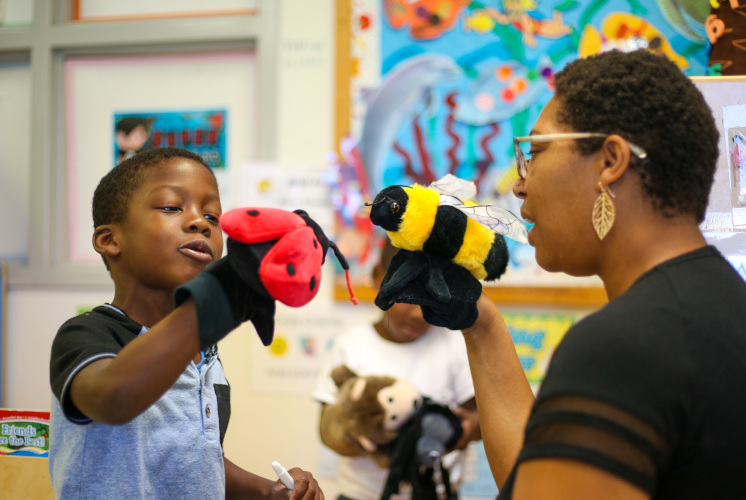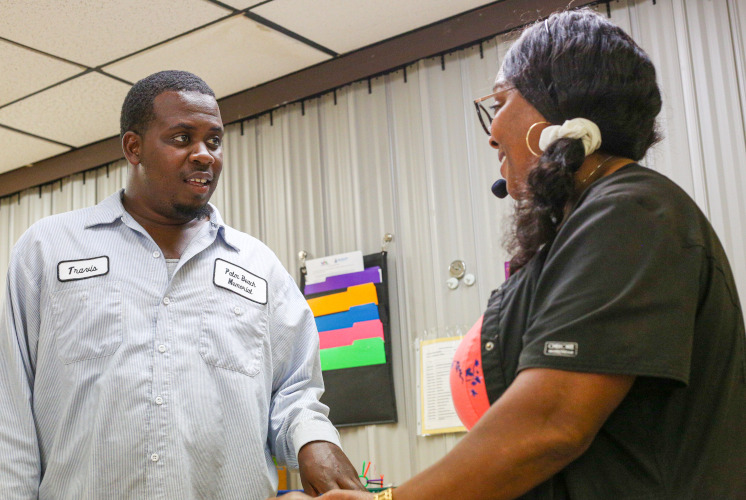 Strong relationships and open communication support children's successful transition to school. Each child's experience in the Head Start program is a journey, from intake to transition to kindergarten. When we develop a partnership with a family over time, we become part of that journey. It starts in conversations and interactions when the family first enters the program, continuing to when their child eventually leaves for another learning setting. Each of our meetings about preparing for transitions is part of an ongoing conversation along the journey.
Strong relationships and open communication support children's successful transition to school. Each child's experience in the Head Start program is a journey, from intake to transition to kindergarten. When we develop a partnership with a family over time, we become part of that journey. It starts in conversations and interactions when the family first enters the program, continuing to when their child eventually leaves for another learning setting. Each of our meetings about preparing for transitions is part of an ongoing conversation along the journey.
Practice Scenario and Strategies
Read about how one early childhood team partners to launch the conversation about kindergarten. Explore the scenario and reflect on opportunities to build relationships with individual families to introduce the process of transitioning to kindergarten.
Kim is an experienced Head Start teacher in a center-based program. Carole has been a family advocate for five years. Before the school year began, they conducted home visits with all of the new families. They asked about their hopes and wishes for their children and their thoughts about the transition to kindergarten. Over the years, Kim and Carole have learned that the move to kindergarten is a big event and is on the minds of families during the last year in the Head Start program. At a pre-service session, they discovered children have a greater chance for future academic success when the transition to kindergarten is smooth.
After reviewing data from home visits, Kim and Carole decided to devote time at the first parent group meeting to launch the conversation about kindergarten. They created a word cloud poster of the comments they heard from parents during home visits to encourage a discussion about their hopes and concerns about the transition. They provided a calendar of transition events and a letter with a year's worth of ideas for families and children.
A parent whose child just started kindergarten came to the meeting and shared her family's experience. She talked about ways families can help prepare for the transition, such as maintaining good attendance in the Head Start program and reading and engaging in conversations with their child as often as possible. Carole told them about an opportunity to become a member of the program's kindergarten transition team, which meets with the elementary schools and plans transition activities.
Sarita, Rodney, and their 4-year-old son, Harvey, have just moved to the community. Harvey will be entering kindergarten next year. Kim checks in with Rodney and Sarita during refreshment time.
Kim: How are you finding Great Falls?
Sarita: I really like it here. I am looking forward to finding where everything is—stores, library, parks for Harvey—and meeting families in the area.
Rodney: We really want to make the most of this year in the Head Start program.
Sarita: Harvey is such a smart little guy. He is pretty outgoing, like me, so he should make friends easily. I really want him to learn to write his name before he goes to kindergarten.
Rodney: I hope Sarita's right about making friends. When I was a kid, we moved around a lot. I remember it was hard to make new friends and get used to a new school.
Kim: In our Head Start program, we get to know each child, their strengths and challenges, and what they need to get ready for kindergarten. We have aligned our curriculum with local kindergarten expectations. We will talk about that together throughout the year, and when the time comes, we help you get to know the kindergarten he will be attending.
Rodney: I think I might like to join the Kindergarten Transition Team you mentioned. What do you think, Sarita?
After the meeting, Kim and Carole reflect on the group discussion and individual conversations with families. They consider what they have learned about the importance of sharing information and building relationships as two key components of successful transitions. Kim makes a note to stay in touch with Rodney about the Kindergarten Transition Team.
Carole includes the handouts in the parent meeting binder and plans to share copies with families who were not able to attend the meeting during her next home visit.
 Strategies
Strategies
Consider your role in the transition to kindergarten. How can you begin to prepare families in the fall?
Leaders can:
- Establish a written memorandum of understanding (MOU) with public school districts and receiving schools within their Head Start service area
- Convene a Kindergarten Transition Team early in the year that includes families, staff, and program leadership
- Provide staff who work with families professional development on relationship-based practices.
- Share current research about successful transition practices
- Schedule opportunities for Head Start teachers to meet with kindergarten teachers
Staff can:
- Use relationship-based practices to develop strong and respectful relationships with families
- Document conversations with families about their hopes and concerns for the transition to kindergarten
- Use the family partnership process to connect family goals with individual school readiness goals
- Apply these goals as you prepare children and families for the transition to kindergarten
Parents can:
- Develop a routine of daily conversation and reading with children
- Have back-up plans for transportation or unexpected events to ensure good attendance
- Share knowledge about their child's progress on school readiness goals with teachers on an ongoing basis during home visits, at conferences, and through text messages
- Get involved in opportunities to meet other families and develop personal leadership skills that will strengthen their advocacy as they move with their child to kindergarten
Featured Resources
- Explore the Building Partnerships with Families Series for strategies to strengthen relationships with families.
- Review the Supporting Transitions: Resources for Building Collaboration series to learn how supporting transitions can have positive effects on children and families.
- Read Family Engagement in Transitions: Transition to Kindergarten to better understand the impact the transition to kindergarten has on children and families. Find examples of how strong Parent, Family, and Community Engagement (PFCE) Framework program foundations and impact areas are linked with successful program practices.
- Review Family Engagement and School Readiness to learn how meaningful family engagement contributes to children's school readiness and healthy development.
- Watch Engaging Families in the Transition to Kindergarten to see how a Laguna, NM Head Start program prepares children and families for the transition to kindergarten.
Read more:
Resource Type: Article
National Centers: Parent, Family and Community Engagement
Audience: Family Service Workers
Last Updated: September 1, 2023